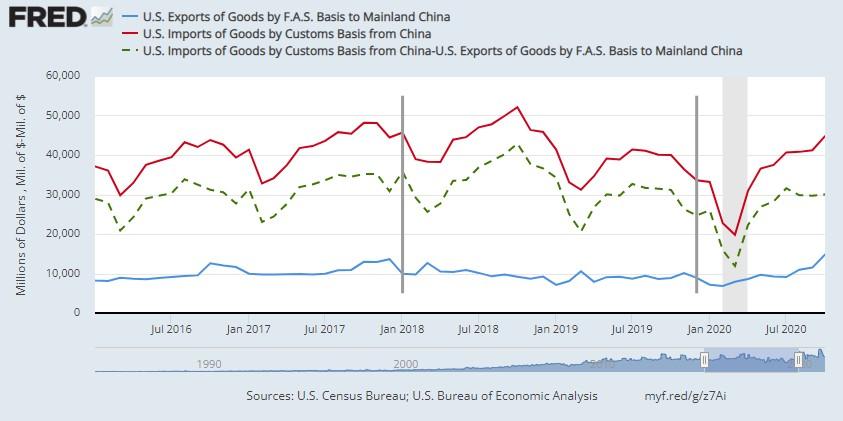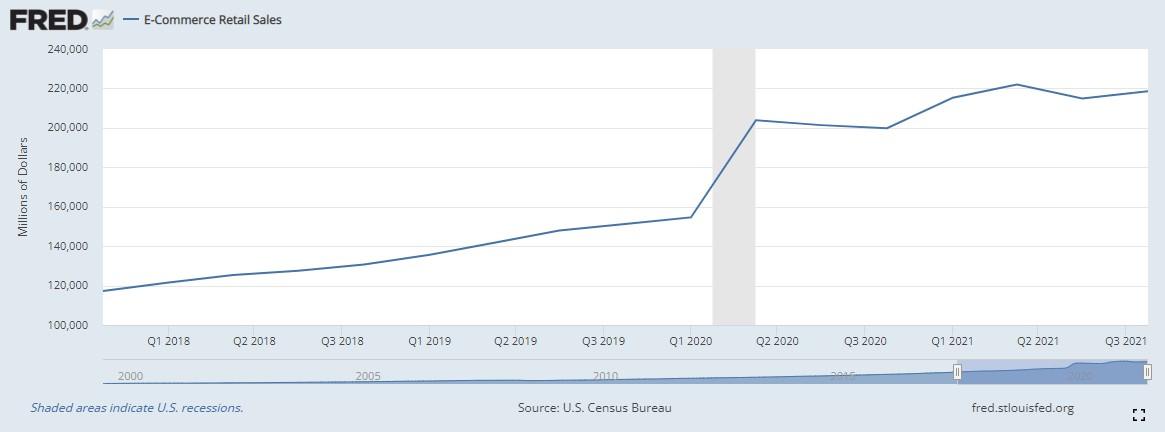Economics is a discipline that may be divided into two major categories, including macroeconomics and microeconomics. While macroeconomics addresses economic-related decisions made by governments and countries, microeconomics studies business decisions that affect individuals’ behavior in relation to supply and demand. However, even though macroeconomics and microeconomics refer to different spheres and subjects, they are interconnected and interdependent complementing one another. This paper will support this statement on the basis of microeconomics principles to substantiate the impact of trade between China and the United States and the trade war in particular on businesses and consumers of both countries.
In general, the disruption of both countries’ economies regarded as the largest ones was unfathomable. Until 2017, China was the United States’ largest trade partner with more than $600 billion in exports and imports (Library of Congress). However, in 2018, guided by “America First” foreign policy based on unilateralism, nationalism, and protectionism, the Trump Administration condemned China for seemingly unfair trade practices and placed non-tariff restrictions and increased tariffs on Chinese imports (Boylan et al. 24). At the same time, it was a ridiculous act of humiliation for China. Although China also introduced responsive measures in relation to U.S. imports, in 2019, Donald Trump “tariffs from 10 to 25% on $200 billion worth of Chinese goods,” including industrial and consumer products (Boylan et al. 24). In the present day, the trade relationships between the two countries remain unstable, especially after the negative impact of the COVID-19 pandemic. Figure 1 demonstrates the continuous decline of Chinese export to the United States with the worst failure during the pandemic when the international trade and global supply chain were corrupted.

It goes without saying that businesses and customers in both countries were almost immediately affected by their governments’ decisions. According to microeconomics principles, supply and demand affect prices, however, prices affect demand and supply as well. In the United States, consumers are more vulnerable to any changes in tariffs resulting from trade wars as “the prices of China-sourced consumer products and components would be expected to rise sharply” (The Economist Intelligence Unit). According to Alex Capri, the representative of the National University of Singapore Business School, in 2018, US consumer price inflation was expected to be 1.5% higher in comparison with baseline forecasts (The Economist Intelligence Unit). Based on the estimation made by The Trade Partnership, a Washington consulting firm, the 25% tariff would cost the average U.S. family consisting of four persons an extra $767 annually (Knott). Only luxurious products, known as Veblen goods, remain unaffected as their demand is not affected by prices and their manufacturing does not require Chinese materials. In addition, domestic manufacturing could not satisfy overall demand as it was not developed or required components and materials imported from China.
As a result, businesses were substantially affected by the US-China trade war in multiple ways. Small companies disappeared without having capabilities for survival while bigger brands had to increase prices, optimize them using inner resources, or temporarily keep them expecting changes in the global environment (Knott). Moreover, in order to remain competitive, they focused on the improvement of their supply chains with machine learning and artificial intelligence solutions as the trade war left “an increasingly small margin for inefficiencies” (Blue Yonder). Retailers aimed to adapt their planning processes on the basis of changes in demand and supply, optimal sourcing options, and material news to react in a time-sensitive manner (Blue Yonder). In other words, companies are expected to attract and retain consumers whose demand had been affected by increased prices through the advancement of their sources of information. These sources would allow them to address people’s preferences and provide quality customer service through demand forecasts and inventory management.
Microeconomics principles state that consumers’ purchasing power is determined by their income regulating demand. According to Scott and Mokhiber, “the growth of the U.S. trade deficit with China between 2001 and 2018 was responsible for the loss of 3.7 million U.S. jobs” and losses continued to increase, especially in the industries of electronics, machinery, and metals. Thus, as previously mentioned, the purchasing behaviors of US consumers affected by prices for the majority of products have changed as well. While some people preferred to save money, others started to pay attention to local or non-Chinese suppliers frequently paying the opportunity cost.
In addition, according to the substitution effect associated with the price elasticity of demand, people may prefer alternatives or cheaper substitutes when prices become unaffordable. As a result, a considerable number of customers switched to online cross-border e-commerce as small orders remained practically unaffected. That is why people from the United States and China increased their use of online shopping platforms, such as Taobao/Tmall Mall, eBay, Amazon, AliExpress, and AliBaba. They continue purchasing daily necessities, clothing accessories, furniture appliances, and 3C products as prices there were more affordable (Liu et al. 178). In addition, online shopping became more cost-efficient for personal stores and small entrepreneurs.
At the same time, the stable growth of international e-commerce reflected in Figure 2 was fueled by the lockdown caused by the global spread of the coronavirus. According to Antonella Teodoro, the representative of MDS Transmodal focused on research in the sphere of transportation and logistics, “the shift in consumer spending from travel, vacation and entertainment events to physical goods, mainly bought online, has characterized all the major western economies, in particular the North American countries” (LaRocco). People order products directly from China avoiding tariffs or tolerating with insignificant increase in prices.

Talking about Chinese consumers, the impact of the trade war on them was regarded as less severe in comparison with U.S. citizens. First of all, the United States was not “a major source of consumer goods imports, aside from some luxury brands” (The Economist Intelligence Unit). Moreover, It was easier for China to find alternatives and replace U.S. products with goods from other countries. At the same time, it was more challenging for the United States “to find new, plentiful sources of low-cost consumer products to replace China-sourced ones” (The Economist Intelligence Unit). In addition, China had fewer offshore production facilities to relocate than the United States.
At the same time, Chine consumers’ purchase behavior was less affected by the US-China trade war. Whether prices increased in this country, this tendency was less determined by the prices of American materials or resources. In addition, local companies that lose the opportunity to export products to the United States in the same volumes as before focused on the Chinese market targeting citizens. At the same time, those Chinese businesses that strongly depended on export decided to relocate their businesses to other countries to reduce tariffs.
To conclude, it is possible to say that macroeconomics is closely connected with microeconomics and affects its principles. From the example of the US-China trade war, it is clear that the political decisions of two countries impacted their businesses and citizens. Companies were forced to adapt to new prices and introduce new strategies to attract and retain cinsumers to stay competitive. In turn, consumers from both countriesstarted to search for alternatives and switch to more cost-efficient online-ecommerce.
Works Cited
Blue Yonder. “5 Consumer Perceptions of the U.S. Trade War with China and Holiday Shopping.” BlueYonder, Web.
Boylan, Brandon M., et al. “US–China Relations: Nationalism, the Trade War, and COVID‑19.” Fudan Journal of the Humanities and Social Sciences, vol. 14, 2021, pp. 23–40.
Knott, Matthew. “’Holding Our Breath’: Trump’s Trade War with China Gets Real for Businesses, Consumers.” The Sydney Morning Herald, 2019, Web.
LaRocco, Lori Ann. “China Exports Surged Late Last Year as Consumer Recovery Picked Up Steam in U.S., Other Nations.” CNBC, Web.
Library of Congress. “U.S. Trade with China: Selected Resources.” 2022. Web.
Liu, Li-Chun, et al. “Online Cross-Border E-commerce Consumer Behavior: A Case Study of Sino-US Trade Conflicts.” Journal of Economics, Business and Management, vol. 7, no. 4, 2019, pp. 174-181.
Scott, Robert E., and Zane Mokhiber. “Growing China Trade Deficit Cost 3.7 Million American Jobs Between 2001 and 2018.” Economic Policy Institute, 2020, Web.
The Economist Intelligence Unit. “Unintended Consequences: The Impact of Trade Wars on Consumer Markets.” The Economist, Web.